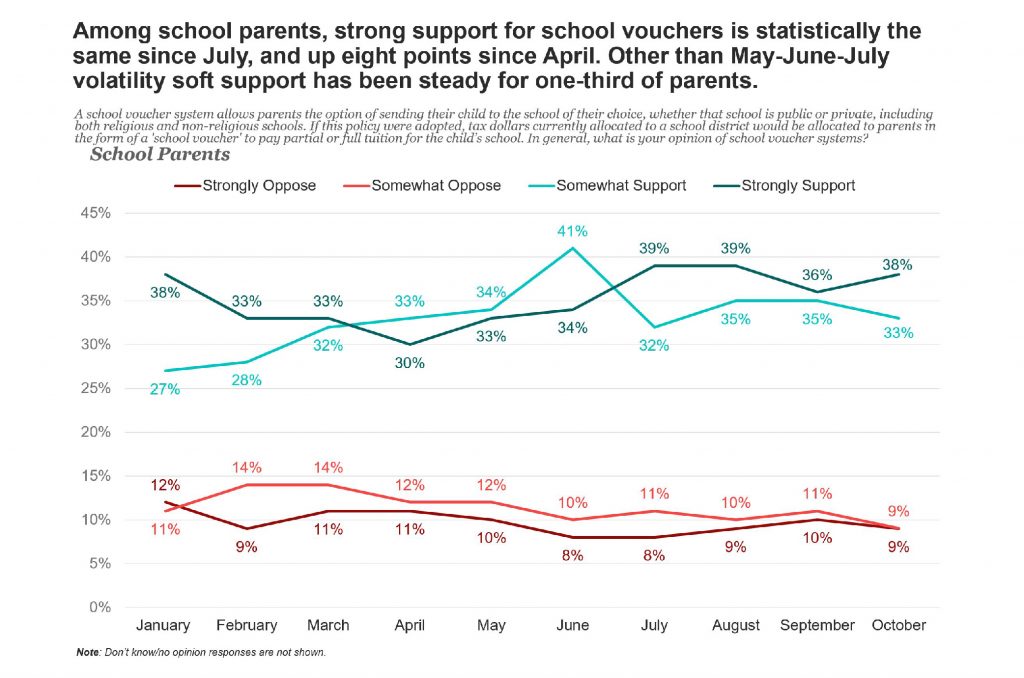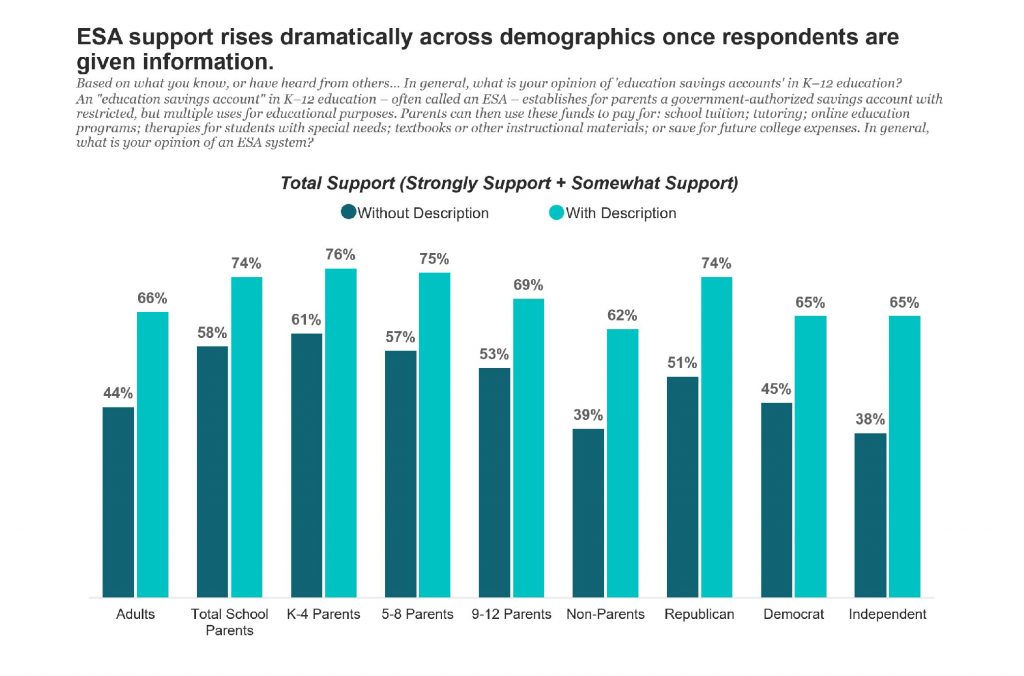EdChoice Public Opinion Tracker: Top Takeaways October 2020
This week, we’ve posted reports based on our most recent survey results that are now posted on EdChoice’s Public Opinion Tracker.
Below are key findings from our most recent monthly tracking poll, which is conducted by Morning Consult. Our survey was based on a nationally representative sample of adults 18 years and older (N = 2,200, in the field October 12–29). With additional sampling, we obtained responses from 1,278 parents of school-age children so we can report subgroup demographics with added confidence and reliability.
In a nutshell: Our tracking poll illustrates snapshots and trends in public opinion. We are also reporting parents’ views and experiences regarding their children’s education during the COVID-19 pandemic. We surveyed 2,200 adults among the general public who answered questions about COVID-19, teachers’ unions and several types of educational choice policies. Nearly 1,300 parents of school-age children answered questions about their children’s learning and how well their schools are managing education and safety goals. That parent sample was obtained from the general public sample and by way of oversampling.
These are 14 highlights that jumped out to our team.
1. The proportion of Americans saying the pandemic is “very disruptive” to daily life are the lowest since we began asking COVID-19 questions back in March. We started asking about COVID-19 disruptions more than seven months ago. At that time, roughly half of respondents said the pandemic was very disruptive to their communities. About one-third said their personal routines had been disrupted. As cases in the United States climbed, those responses jumped to 56 percent and 44 percent, respectively, in our April survey. Since then, feelings of disruption have steadily declined.
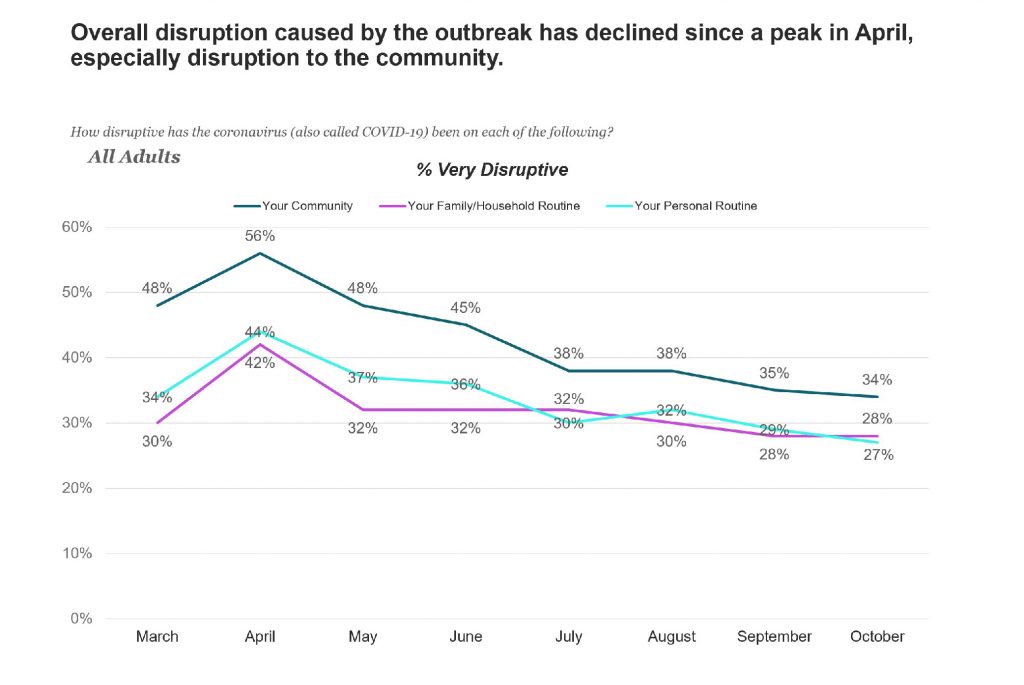
2. Parents are rather split in terms of how comfortable they are sending their children back to in-person school. A slight majority (53 percent) said they are comfortable with their children returning to school. Not only are parents evenly split about their comfort with in-person schooling, but also they are evenly split between their extreme positive and negative intensities. Parents’ projections for when in-person schooling would be safe varied. Just over half (51%) said they think in-person classes will be safe by January 2021, and just under half (49%) said it will take longer or were unsure.
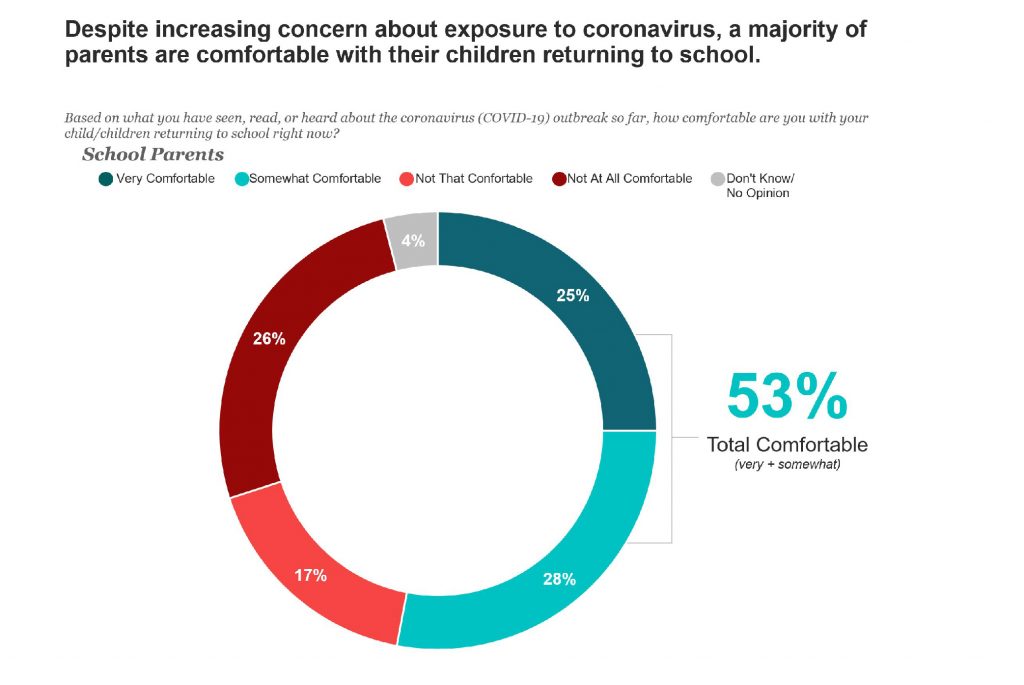
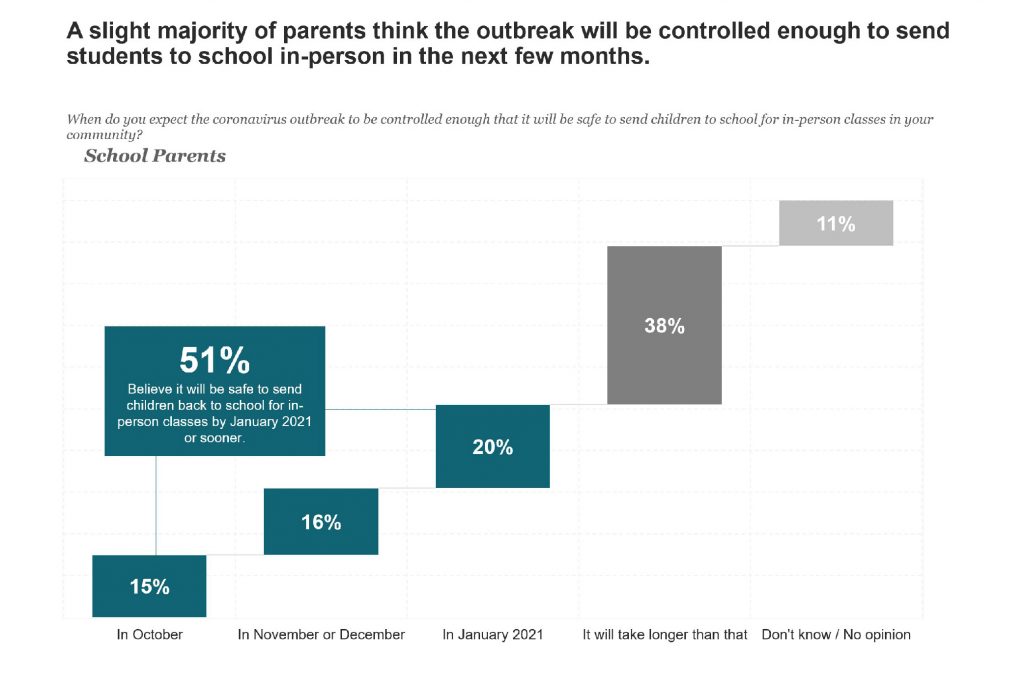
3. Parents are more concerned about their child being exposed to COVID-19 than they were in September. The percentage of parents (82%) reporting feeling very or somewhat concerned about coronavirus exposure jumped six points from September to October. Three out of four school parents gave the same response about their child missing instructional time.
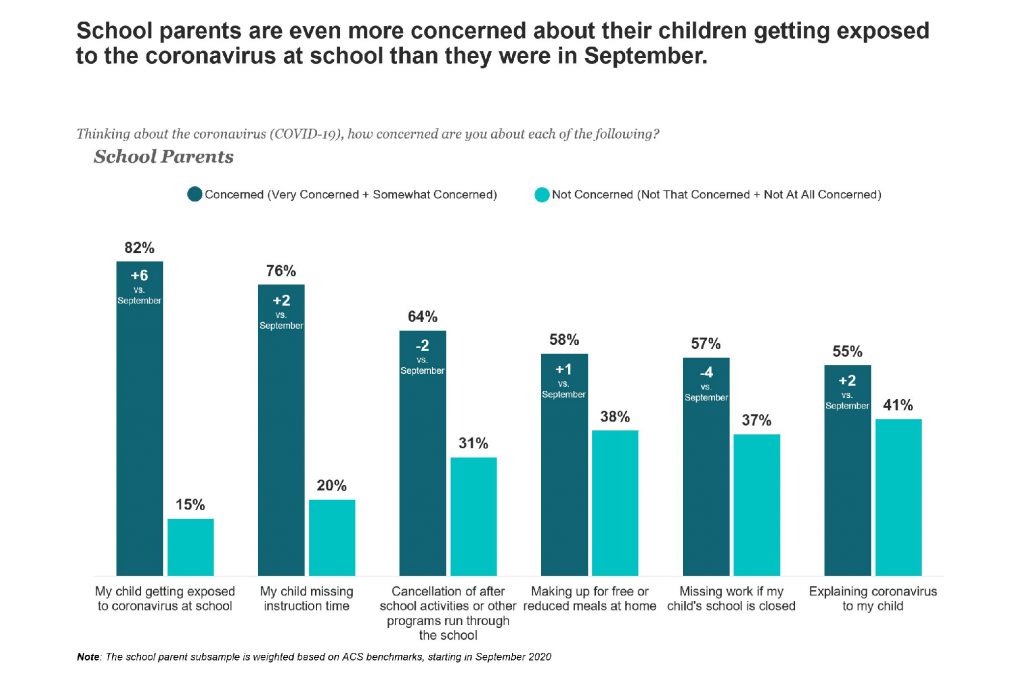
4. Parents are optimistic about the impact of virus-related safety procedures at schools. At least three of every four parents think one of our example safety measures can be very or somewhat helpful in keeping schools healthy learning environments. Increasing disinfection and cleaning practices is the most highly rated policy at 86 percent. A majority of parents think eliminating recess is a helpful option, though parents rated it noticeably lower than all other measures.
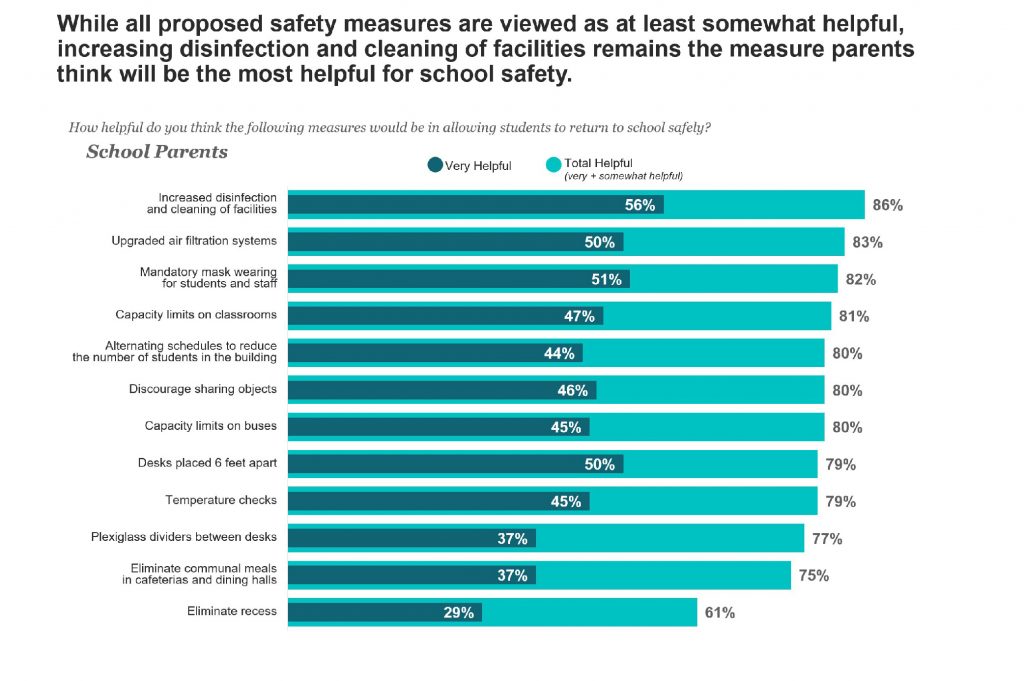
5. Most parents want and have multiple learning options for their children this fall. Two-thirds of parents said they think schools should provide multiple learning options for K–12 students this semester. Four out of five parents report their children’s schools allowed families the choice between in-person and virtual learning. Of the 20 percent of parents who reported their children’s schools offered only one option, three-fourths said online learning was the only option while the rest said their children had to attend in person.
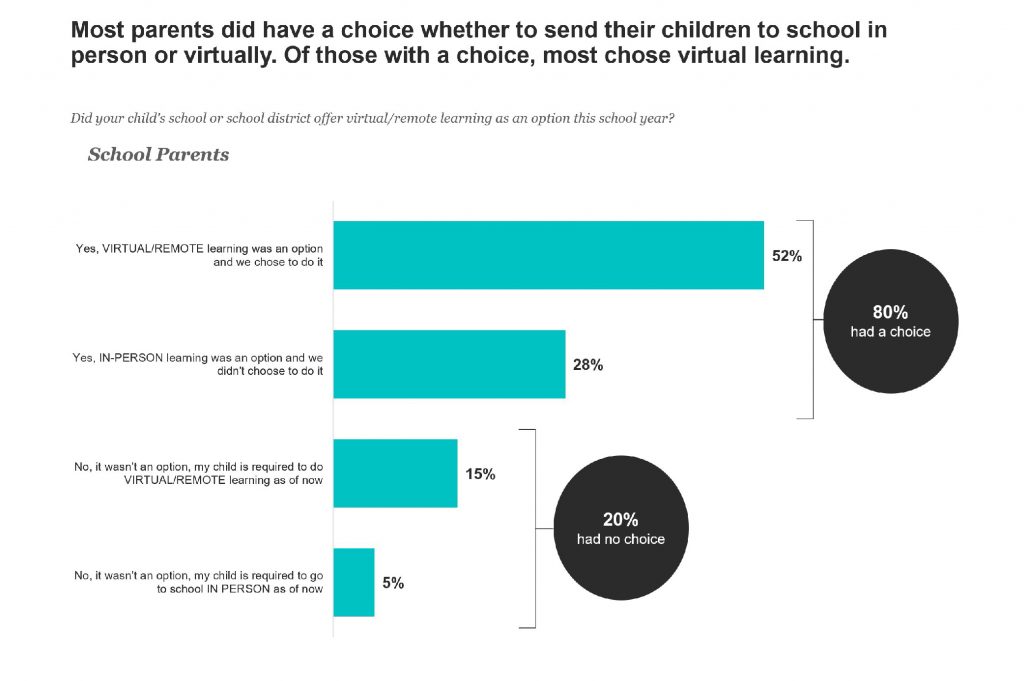
6. Even more parents are homeschooling their children now—a 9 percentage point increase since the start of the 2019–20 school year. Most of the homeschool switchers came from traditional public schools. Seven percent of children were homeschooled at the start of the 2019–20 school year, long before spring school closures. This school year, we estimate 16 percent of children are being homeschooled. There appears to be a 10-point drop in enrollment among public district school respondents. Most of these switchers opted for homeschooling. Based on parent reports, we estimate 22 percent of children switched school types from 2019-20 to this current school year. And we estimate that 43 percent of all students who switched sectors this school year were public district school students switching to homeschooling.
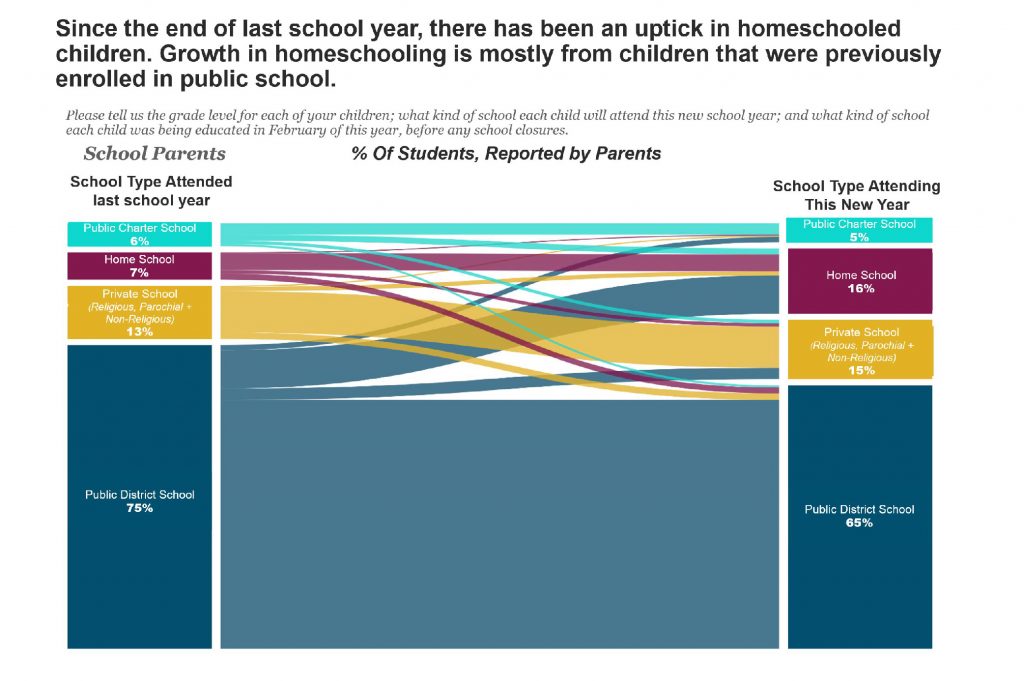
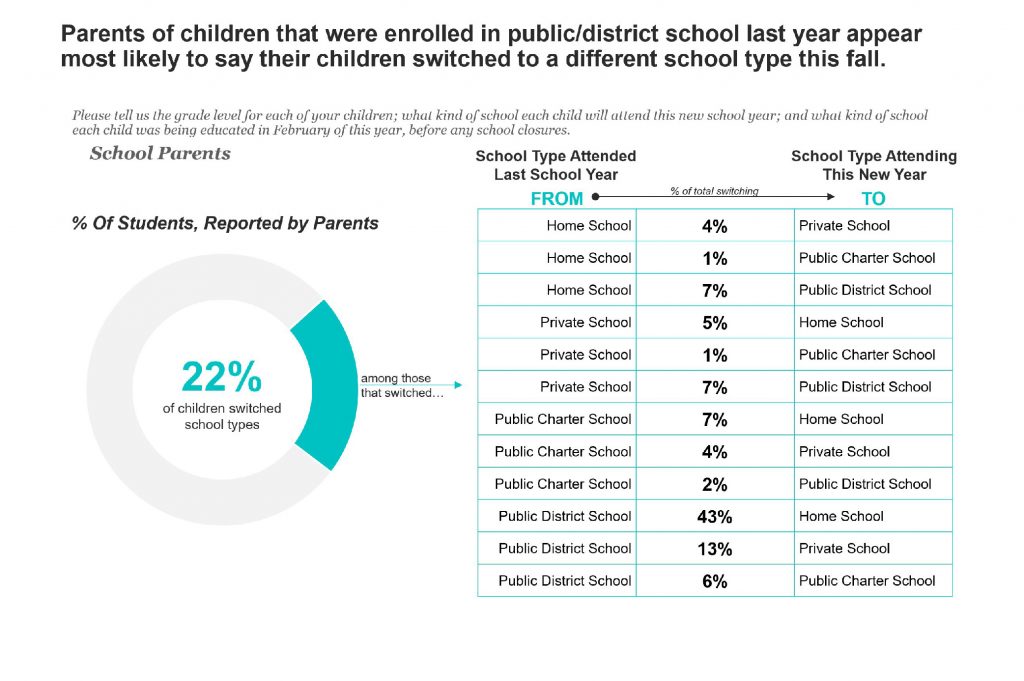
7. Private and public charter school parents are more positive about their children’s progress in school during the pandemic than public district school parents. About a third of parents of children in public district schools say their children are progressing “very well” this school year in their academic learning, emotional development and social development. Nearly half of private and public charter school parents are very positive about their children’s academic learning. In emotional development, 47 percent of public charter school parents and 42 percent of private school parents rate their children’s progress as very good. Social development received the most even responses of the three categories of development, but private and public charter school parents remained the most positive about their children’s development at 45 and 40 percent, respectively.
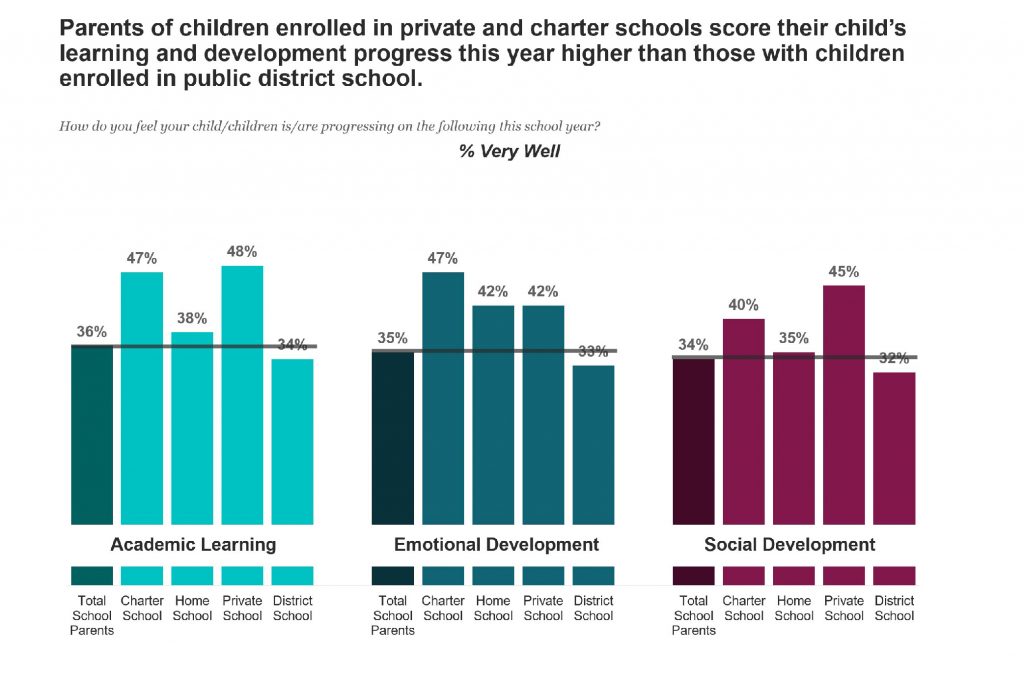
8. The vast majority of parents with children in “pandemic pods” (or learning pods) are using those pods to supplement regular schooling as opposed to a complete substitute for regular school or virtual learning. Last month, 31 percent of parents said they are participating in a pod. Of that group, 85 percent of parents said they used pods as a supplement to regular schooling as opposed to replacing their children’s usual schooling option. An additional 18 percent of parents said they were not yet in a pod but were looking to join or form one. Most of these parents also saw pods as a complement to rather than substitute for “normal” school, though at a smaller share of 67 percent.
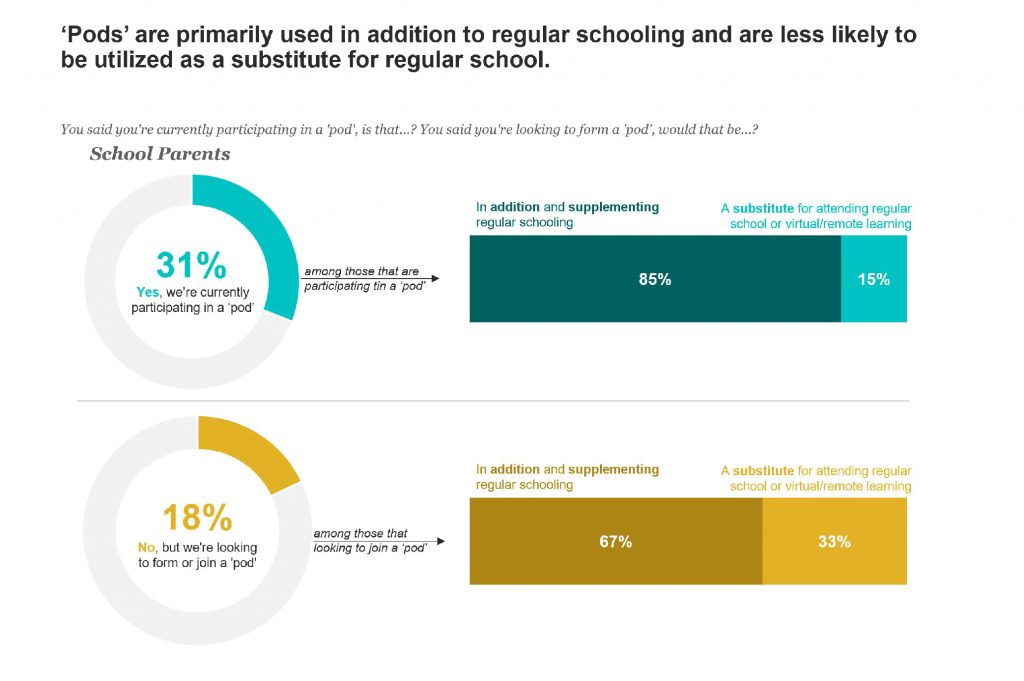
9. Pandemic pod participants are likely to attend, or have previously enrolled in, a private school and public charter school. Last month, we learned that households with higher incomes and households with younger children are more likely to participate in pods. This month, we learned that children enrolled in public charter schools and private schools are especially likely to be participating in pods this school year. About two-thirds of charter school families, three-fifths of private school families, two-fifths of homeschooling families and one quarter of district school families are participating in pods.
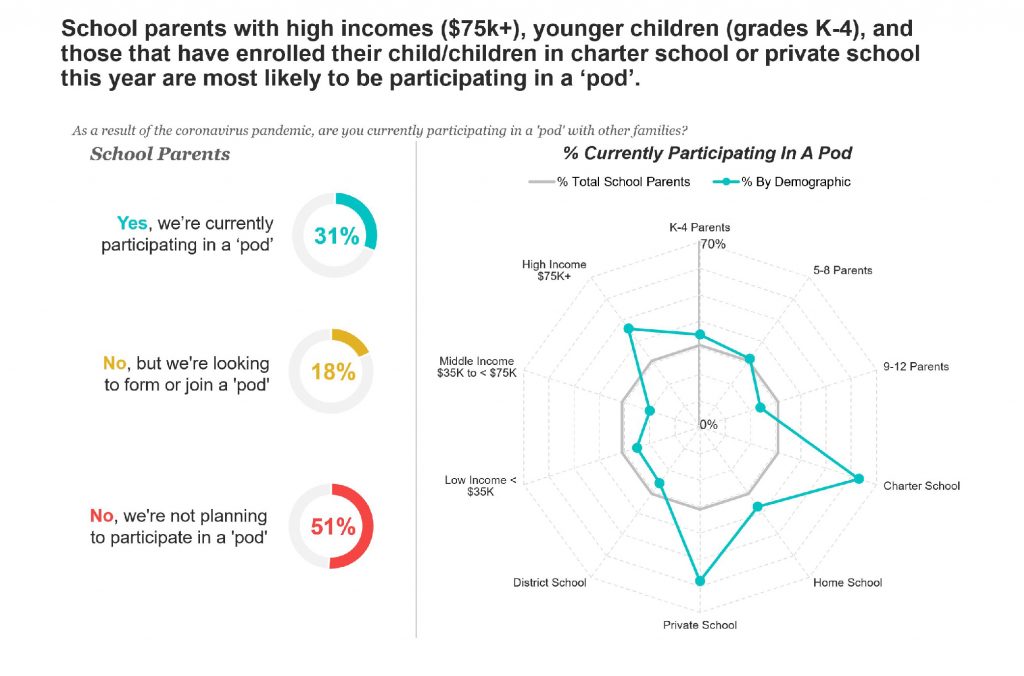
10. Favorability toward homeschooling holds steady at 36 percent. In March, we began asking all respondents (not just parents) if their opinion of homeschooling had changed due to COVID-19. About a quarter of all responding adults said they became “much more favorable” toward homeschooling, a number that remained steady for several months. In July, that number jumped to 43 percent but ticked back downward in the following two months, hitting 36 percent in September. That decline appears to have slowed in October, which repeated September’s result. Overall, two-thirds of respondents indicated they had grown at least somewhat more favorable to homeschooling.
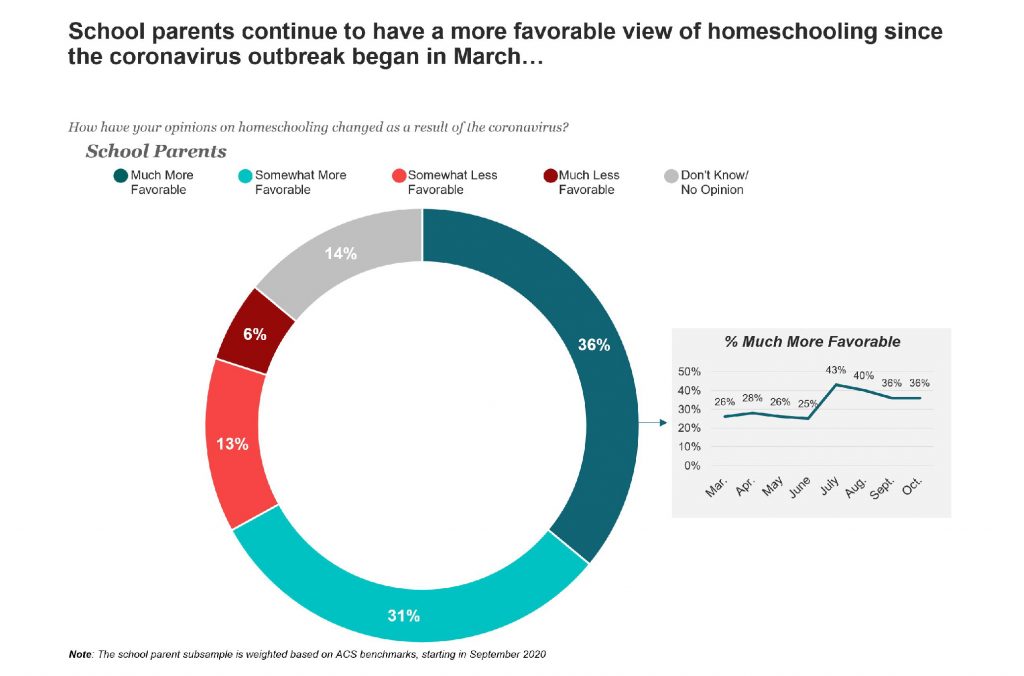
11. Optimism about education appears to be on the upswing. This month, more respondents felt that education on local, state and national levels is moving in a positive direction than in September. Before September-October, upticks in positivity toward all three levels hadn’t occurred since March-April.
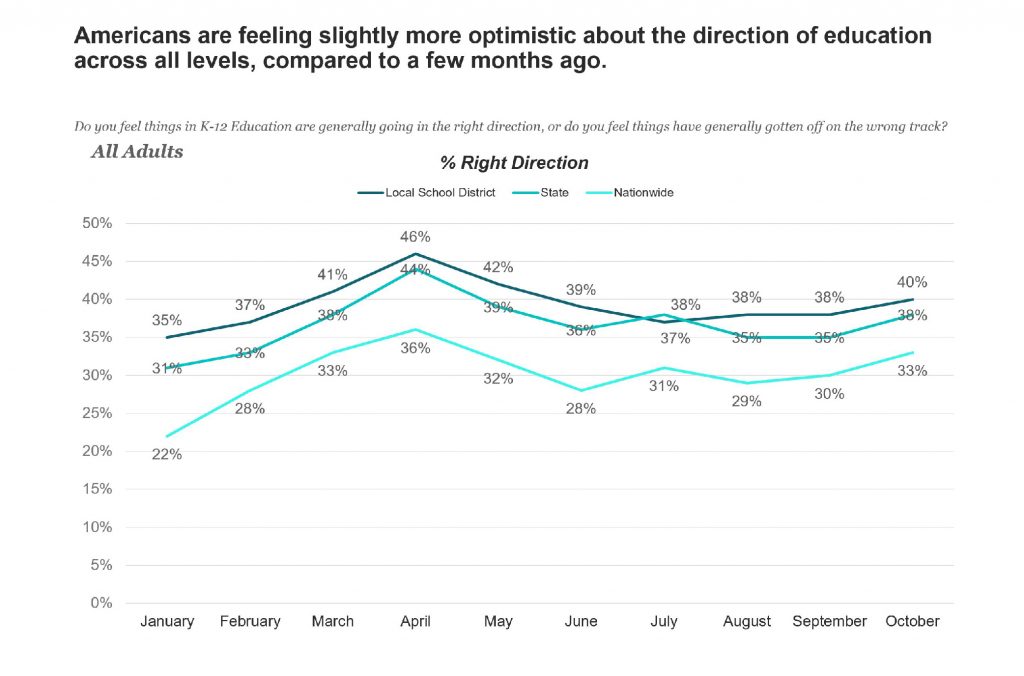
12. Support for charter schools remains at or above 62 percent for the third consecutive month. After a four-point drop in overall support in July, respondents somewhat or strongly supporting charter schools increased to 62 percent in August. That number reached 63 percent in September and again in October. Intensity of opinion, both positive and negative, also remained stable. Among parents of school-age children, support has remained between 69 and 71 percent during the last three months.
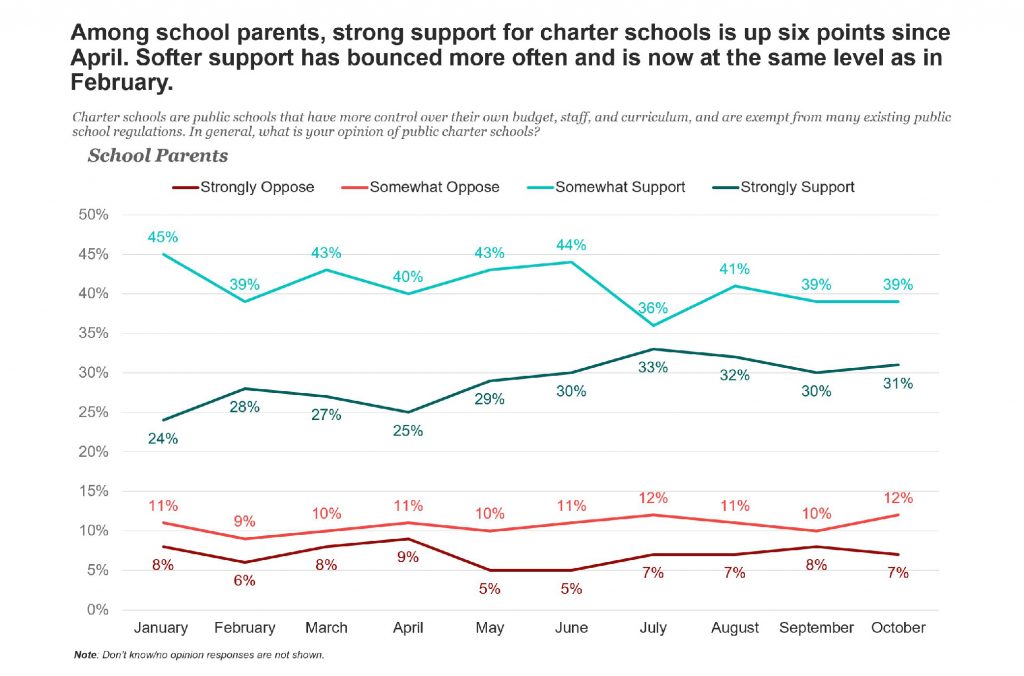
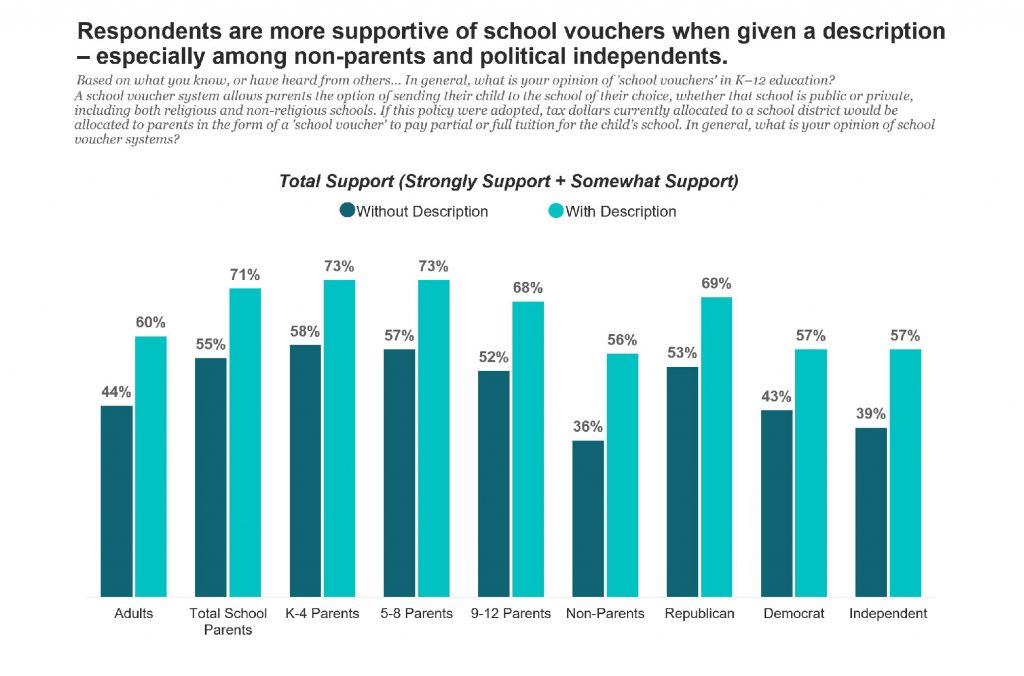
13. Opinions on education savings accounts (ESAs) saw mild shifts in intensity. Respondents who “somewhat support” ESAs decreased by 3 percent, but those who “strongly support” ESAs increased by the same amount. Among parents of school-age children, feelings appeared to grow slightly milder in either direction. Unlike July through September, “somewhat” supporters outnumbered “strong” supporters in October.
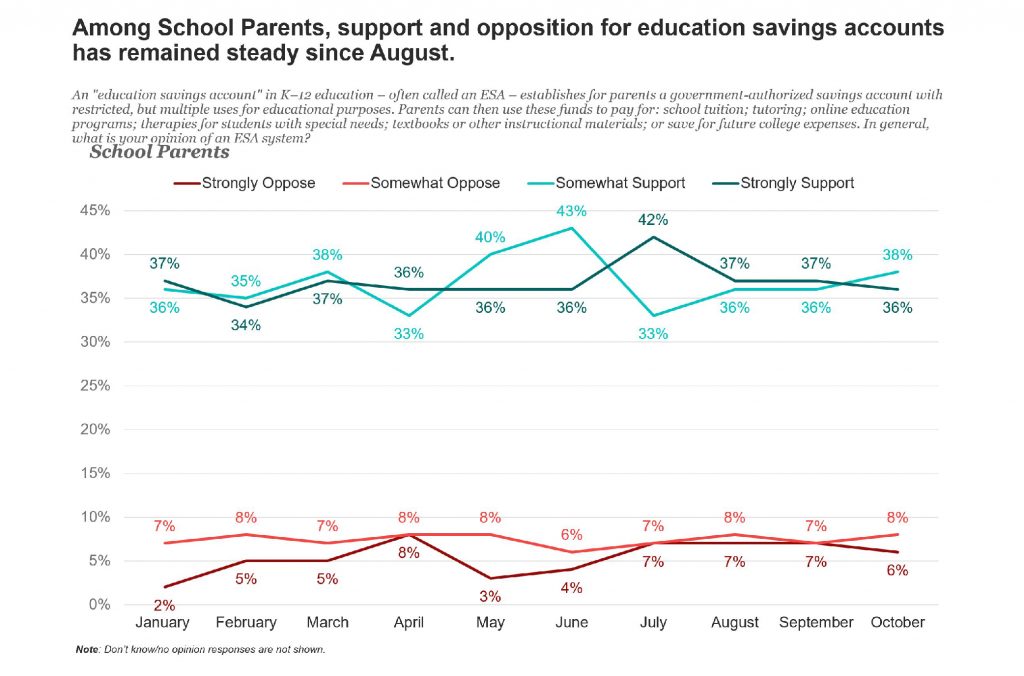
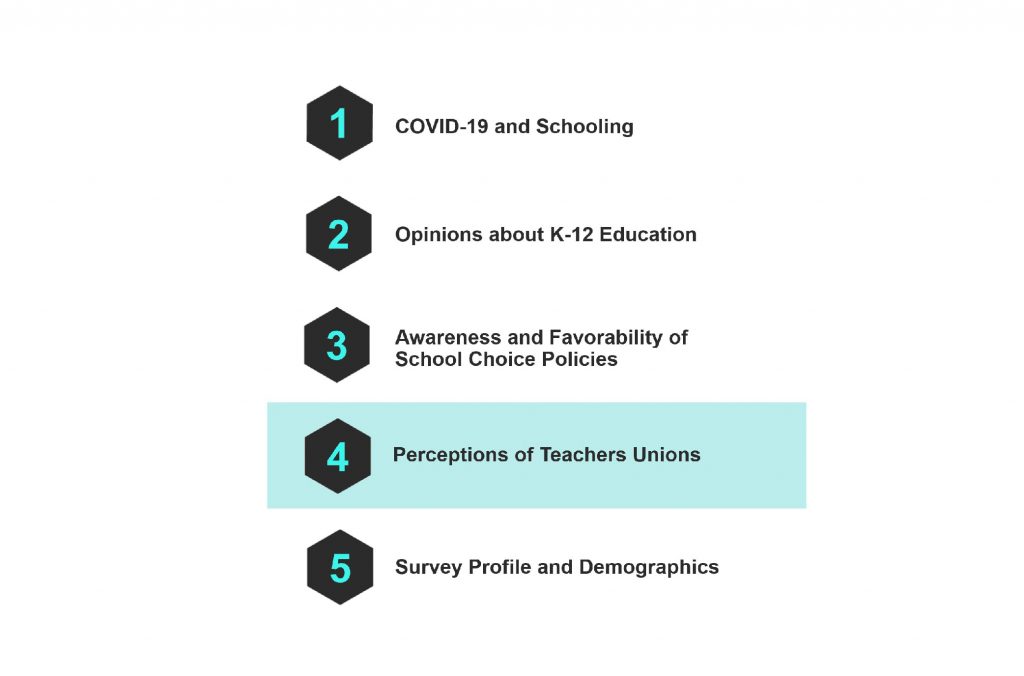
14. Support for school vouchers has maintained an upward trajectory since spring. Back in February, less than one in four adults voiced strong support for school vouchers, and opposition reached its high for the year at 27 percent. In October, strong supporters reached 31 percent of all responding adults, higher than “somewhat” supporters for the first time in 2020. Parents began the year strongly supporting school vouchers at a rate of 38 percent, which dipped to 30 percent in April. That number is back to 38 percent in October. Opposition dropped by a combined two percentage points from September to October.
